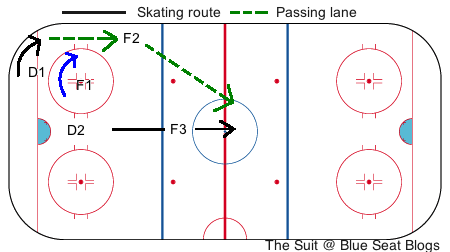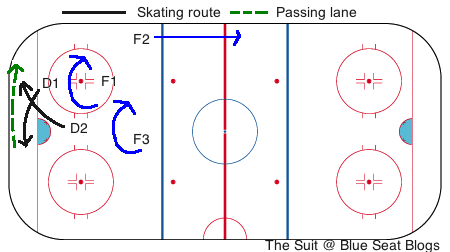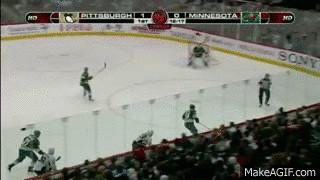Last season was an oddity for the Rangers. They didn’t maintain their solid possession game from the prior season, one which carried them to the Stanley Cup Final, but their scoring was up. It was tough to argue with the results, even if the process changed. The process change was subtle, it simply shifted the focus on using the tremendous team speed to generate chances off the rush.
It was something I broke down last season, as the Rangers appeared to have set plays for this. They had the stretch pass, the blue line to blue line pass, and the “Chris Kreider play.” They also forechecked in a manner designed to force a turnover at either blue line and turn the play the other way. It was magnificent to watch, as the team speed was put on full display.
Now, it seems the style of play has caught on to the rest of the league. Teams are anticipating the forecheck and breaking through, creating rush chances of their own. They are also anticipating the stretch passes that generate so many rushes.
The result is significantly fewer rush chances for, and higher rush chances against. Sean Tierney (who is a brilliant follow for those looking to understand stats. He explains it nicely with great visuals) broke this down very nicely for us in the below tweet.
Here's rush rates for/against from last season and this season. #NHL pic.twitter.com/HTkaVOw8Ld
— Sean Tierney (@ChartingHockey) April 5, 2016
What this shows us is last year’s rush chances for and rush chances against (left picture) against this year’s (right picture). To read the chart, the upper right quadrant, where the Rangers were last season, means a team generates a lot of rush chances and limits them against. The bottom left –where the Rangers are this year– is the exact opposite, allowing many rush chances against and not generating many for. For educational purposes, the bottom right is a high rate for both (fast paced games) and the top left is a low rate for both (slow paced games).
The Rangers went from averaging approximately 3.1 RSF/60 to 2.4 this year. On the surface that’s not necessarily a bad thing, but that is also coming with an extreme drop in possession (49.5% CF to 47.2%) this year. Compounding the situation is the rise in RSA/60 from 2.4 to 2.8. That’s not a meteoric rise, but it’s something that adds to the multitude of issues facing the team this year. Simply put, the rush based offense isn’t working as well this year.
From the drop in rush effectiveness, we can infer that the Rangers are not only getting defended differently this year, but the opposition is shoving their own game down their throats. It’s rare when the Rangers are able to execute plays like this one from Keith Yandle.
https://twitter.com/BlueSeatBlogs/status/712801098734632961
There are a multitude of reasons for this, but there are three that stick out to me. First is that the Rangers are not as fast this year. I’m not just talking on-ice speed, I’m talking decision making speed. They’ve slowed down. Losing Carl Hagelin plays a role in this, but Viktor Stalberg is faster than any fourth line player the Rangers had last season.
Second is that the opposition, all 29 other teams, are getting faster. The game is evolving into a speed and skill game. The advantage the Rangers had last season with their speed is getting nullified. Seems simple, but often overlooked.
Third, and most critical, is that teams are defending against it and burning them in the process. Since I still can’t access archived games on the new NHL.tv*, the only gifs I have available are ones I’ve tweeted at some point or another.
*-How in the world could they botch the launch this badly? They couldn’t wait until the season was over to beta test it? They rushed it, and delivered crap. Just like the “enhanced stats” site.
https://twitter.com/BlueSeatBlogs/status/714258354999279616
I know this is Phil Kessel, and that he burned everyone in this game, but this is one prime example of how he uses the neutral zone to pick up speed. Ryan McDonagh isn’t caught flat-footed here, its just he can’t catch Kessel. This is how the speed game is being used against the Rangers.
Here’s a rush from the Panthers game against the Rangers. This one hit the post, but notice how the Rangers are unable to get back to join the play.
https://twitter.com/BlueSeatBlogs/status/712091441779105794
Those are just two examples of speed being used against the Rangers. It explains the big jump in rush chances against, from the chart from Sean above. I am unfortunately unable to get gifs of specific plays where the Rangers attempted one of their patented rush plays, but I can at least explain the difference in defense.
For starters, when the Rangers are on the forecheck, teams understand the first man in will pressure the puck, and depending on puck location/play, the second will pressure the primary passing option, while the third will pressure the secondary passing option. Or at least that’s how it should be. In reality. the Rangers keep two guys around the blue line who read and react. Teams are now giving the puck carrier more options, which alleviates puck pressure and provides outlets. The reverse breakout works well for this, executed below (more on breakouts here).
In this gif, you see a 1-2-2 forecheck from Pittsburgh, where F1 pressures the puck carrier (D1), so he simply reverses back to D2, with three forward options on that side of the ice. Notice the Penguins only have one forechecker to cover three options for the Wild. The reverse breaks through a predictable forecheck.
Beyond the forecheck, the Rangers rely on stretch passes and the quick-up breakout (pictured at the top, put down here as well so you don’t have to scroll) to generate their own scoring chances. This type of breakout draws attention to the boards for D1 and F2, but the purpose is to hit F3 hitting the neutral zone with speed. And that is the biggest difference in how the Rangers are being read like an open book. This is their primary breakout, and teams are gameplanning for it. They leave two defensemen back at the red line, cutting off F3 in the process.
The problem with this is two-fold. First, the Rangers are extremely predictable, and those defensemen the opposition leave back know the pass is coming. They can cut off the passing lane, simply play back enough that it’s a 1-on-2 rush, or both. We’ve seen this many times where the Rangers try this play, and are forced to dump the puck into the zone because they have no options.
The second is that the defense can predict the pass, pick it off, and start a rush the other way. While I don’t have specific plays –stupid NHL.tv– I at least remember a few instances where active defensemen read the play and transitioned to a forward just waiting at the blue line for a transition rush. Alain Vigneault is a great coach, but he’s becoming predictable.
Much like I theorized last year that the Rangers have transitioned to a rush-based attack to their success, that same attack style is a big detriment this season. The Rangers still score because their forwards are skilled and deep, but a predictable offense means a quick out in the playoffs. Adjustments need to be made. But will AV make them?
Share:
More About:Hockey Tactics



